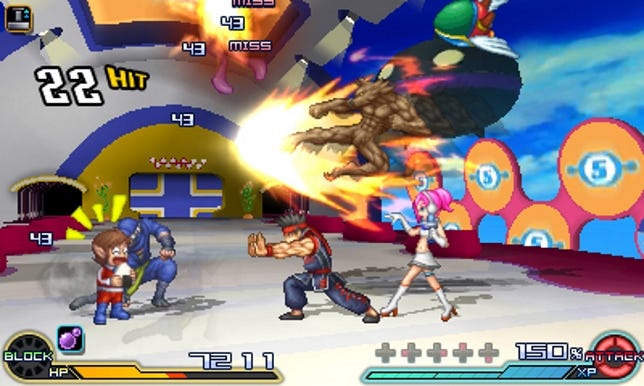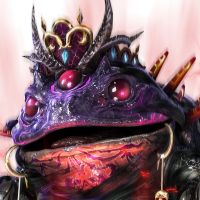
Featured Blog | This community-written post highlights the best of what the game industry has to offer. Read more like it on the Game Developer Blogs.
Ostensible Improvements: When Better Isn't
A look into design changes in sequels that should result in better games but don't.

Ostensible Improvements: When Better Isn’t
Today I’m looking at sequels with design changes that are ostensibly improvements but in practice have negligible or even negative impact. This is the intellectual cousin of my blog on incoherent game systems but with a key difference: in that piece the design decisions looked dubious even in theory when closely examined, whereas these sequel changes appear to be slam dunks on paper.
This piece will examine three types of dubious improvements:
Genuine improvements that are conservatively iterative enough to be more than cancelled out by the passage of time
Improvements that are in some sense objectively better but don’t make the game as a whole appreciably better
Improvements motivated by textbook good design that result in a worse game
Better But Not Better Enough
I recently began playing Super Mario Galaxy 2. It’s the rare straightforward Mario sequel from a company that normally eschews the standard “bigger, better and more badass” (AKA “conservative iterative improvement") approach. There are probably arguments to be made that Galaxy 2 is better than 1, and had I played them side by side or in reverse order I might agree. But playing them in release order Galaxy 2 feels fun but inessential — probably the most skippable game in the series.
Everyone is familiar with the concept of sequel and genre fatigue so I don’t need to elaborate. The point being that minor design changes, even when inarguable improvements, often can’t counteract the downward pressure of boredom with familiarity. As the number of “bigger, better more badass” franchise entries increases the less “is this game better than the last?” is a relevant question; the pertinent question becomes "is it better enough to outpace fatigue?"
Better in Ways that Don’t Matter
Project X-Zone 2
One of my favorite 3DS games is Project X-Zone, a Namco / Sega / Capcom crossover “strategy RPG” that takes no real strategy of any kind. Unit formation doesn’t matter, range doesn’t matter. There’s little unit differentiation — in most SRPGs you’d have a tanky low-damage front line protecting glass-cannon offensive units — in PxZ the units all feel roughly equivalent.
One of the weakest elements of PxZ design is the use of super and special moves. Both moves draw from the same globally shared resource bar. A super move takes 100% (out of 150% max...don’t ask me!) and can more than double the damage you do; a special move can take 30% of that same bar and do an extra 15% damage. Why would you ever use the latter given how XP inefficient it is? Answer: you wouldn’t, rendering 90% of the special abilities in the game useless.
I was very excited when I read about Project X Zone 2‘s changes. It struck me as similar in spirit to the detailed document the Final Fantasy XIV: A Realm Reborn team put out, illustrating that they understood the concerns of the player base and had an eyes-wide-open view of the problems with the game. Almost every issue with the strategy layer of PXZ1 was being fixed in 2, bolstered by some nifty additions. Characters do extra damage when attacking from the side or back — positioning now matters! Special moves now use a unit-specific resource rather than drawing from the same global super move resource, meaning special abilities and super moves no longer compete against each.
The sequel introduces a leveling system that lets you power up individual moves and a character customization system that lets you choose passive and active abilities. More player choice, strategy, personalization and “reward loops” huzzah! The game even has Roman Cancels and Force Roman Cancels — google it!
Project X Zone 2 fixes every mechanical problem with the original. It’s like they read my mind when planning the sequel.
But then I played the game and those changes make almost no difference.
The big problem with PxZ2 is that while the strategy ceiling has been raised the difficulty has been lowered. The game is so easy (at least to me, being decent at these types of games) that any application of strategy is purely optional. You can attack from the back for extra damage, use special moves to increase movement options, use Force Roman Cancels to develop long and damaging custom combos — but you can easily beat levels purely by bumbling through them.
Tellingly the IGN review makes no mention of any of the system improvements at all. None! Despite the mechanics of the game being radically overhauled the review signs off with “Don’t come expecting deep gameplay or even inventive updates to distinguish it from the previous game.” While that’s not exactly right it’s right enough in spirit — the game is significantly updated, but along an axis irrelevant to overall enjoyment.

The main reason to buy PXZ2 is not for the mechanics but because you can call the werewolf dude from Altered Beast to fight alongside Opa-Opa from Fantasy Zone, Ulala from Space Channel 5, Kage and Akira from Virtua Fighter, and, uh, whatever that squirrel thing is.
Low difficulty rendering the advanced mechanics superfluous seems to be the biggest issue with the game, but I'm not convinced that making the game hard enough to require the proper use of mechanics would make the game better. My favorite moment in part 1 is the introduction of a Gain Ground level that includes that game's unique character collecting system. The reason I love this moment is that I @$*!ing love Gain Ground (the secret best Sega game) and it makes me happy that someone somewhere remembered it exists. Similarly my favorite moment in part 2 is when Ken and Ryu fight against M. Bison, using the sequence of moves and the soundtrack from Street Fighter II: The Animated Movie. (Snob voice: the Japanese version)
These are pure fan service moments, not gameplay elements. But the strength of the game — the entire point of the game — is fan service. A harder game with a realistic possibility of losing would mean repeating levels, and while that can be fun in a more strategy-oriented SRPG like Fire Emblem it would be jarring in such lighter fare. Turning the game into a challenging, mechanically satisfying one would take a lot of work, even on top of the substantial amount of work put into the sequel. It would require a radical transformation. The sequel improvements fail to make the game meaningfully better because while much work was put into strategy elements ultimately it's still not a strategy-centric game.
Tacoma
Along the lines of Project X Zone 2 is Tacoma. I'm fairly certain nobody has made this particular comparison before, but read on! (I realize Tacoma is a follow-up, not a sequel, but it's close enough — if it makes you feel better imagine the main character in Tacoma is the girl from Gone Home grown up.)
According to SteamSpy Gone Home has 700k owners. Tacoma has 26k. Gone Home was a subject of conversation for years, Tacoma for days. It's not my place to say that the game was a disappointment commercially or critically — I haven't played it nor do I know what the budget or sales expectation was. But it feels safe to say that it underperformed in some sense.
Revamping Tacoma to be more than 'Gone Home on a space station', in which the creators explain the differences and improvements from Gone Home to Tacoma is an interesting read in that the focus is squarely on mechanical improvements. The problem with Project X Zone 2 is that the improvements were mostly mechanical to a game that was not mechanics-driven, and I suspect that is even more true of Tacoma. (Normally I'm loathe to talk about games I haven't played, but this section is based on critical and audience reception, not my personal opinion)
My understanding of Gone Home is that the appeal is the subject matter, the atmosphere and the nostalgia. The mechanics are Resident Evil 1 style "pick up and rotate objects." Often when effusive critics write about the mechanics of the game what they praise is the lack of mechanics, as in this Atlantic piece:
Gone Home also feels a bit like an experiment. It's a new, effective attack on the convention that in order to be plausible and poignant, game stories necessarily need more complicated systems, higher-resolution graphics, the participation of real-world actors, and heaps of choices and rewards
The pitch for Tacoma is that it's more mechanically interesting, an embrace of the convention that the previous game rejected. If adding more mechanics makes a narrative game better isn't the endpoint just...Bioshock? (I would note that my favorite narrative game, Kamaitachi no Yoru AKA Night of the Sickel Weasel AKA Banshee's Last Cry, has no mechanics at all!) In Tacoma you can rewind and fast forward conversations to create interactive CSI-style re-enactments. When the devs speak of "active" vs "passive" observers the distinction is not emotional engagement or attentiveness, it's APM. The idea seems to be one follows from the other — that players who are more mechanically involved will also be more emotionally involved, but that may be a plausible-sounding non-sequitur, especially considering the success of the first game. If anything I suspect that using tech tools to explore conversations makes an experience less emotional and more clinical, encouraging left-brain thinking. I've seen "Sleep No More" (an inspiration for the game) effusively praised but never has that praise been that it's emotionally engaging. Instead it's wonkish appreciation for the elaborate construction.
So how is Tacoma like Project X Zone 2? Both games improved upon largely irrelevant aspects of the first game, while doing little to improve (or even taking a step back from) the core appealing elements of the original. Tacoma may be more mechanically advanced than its predecessor but those advances were met with a collective shrug because mechanical complexity was never the point of the game. And while the systems may be more advanced they're still relatively simple; in neither game did the systems improvements pass a relevancy threshold.
Other
I once worked on a game that was sent out for a mock review / analysis. It came back with a list of suggested improvements, and when we made all the improvements and resubmitted it the response was “you did everything we wanted but ultimately the game isn’t any better.” Which was disappointing but unsurprising — if mock reviewers knew which specific changes to make to improve a game they’d probably be game designers.

I was going to include a picture of the "feels bad man" frog but I guess that frog is racist now or something, so here's a different frog.
When I first played Earth Defense Force I made fun of how bad the upper body animation was, but better upper body animation wouldn’t make EDF appreciably better. (I’ve since repented and now recognize the majesty of EDF) Earth Defense Force: Insect Armageddon contains the most “objective” improvements in the series but is the red-headed stepchild of the franchise.
Counter-intuitive as it may be it’s possible to undeniably improve an aspect of a game without improving it as a whole.
When Better is Worse — Silent Hill Homecoming
Now onto the most interesting category of changes: on-paper improvements that directly hurt a game.
I covered the Tactics Ogre PSP remake in my blog on incoherent design, but I’ll mention it again to make one point: almost every individual change sounds like the sort of “good design” conventional wisdom you see repeated in medium posts, conference keynotes and youtube videos. Ability points add more long-term goals and another reward / compulsion loop. Redundant death failsafes make the game “more accessible.” Special moves allow for more strategy and variety. The changes in the remake read like a greatest hits of game design wisdom, the sort of pro tips you’d see in a “can’t miss” tweetstorm. But in practice these changes are bad, and together they are multiplicatively bad.
The Main Course
The game I want to talk about in detail here is Silent Hill: Homecoming.
The Silent Hill series was often lumped in with Resident Evil under the umbrella of horror games with clunky controls and rudimentary combat, despite that only the first game uses classic RE style tank controls. The PR for Silent Hill: Homecoming focused heavily on better combat and the game was made by a western developer during the height of the “Japanese games just suck” hysteria that brought us games like Yaiba: Ninja Gaiden Z and Lost Planet 3.
Here’s a wiki description of Homecoming’s combat improvements:
In contrast to the more naïve everyman protagonists of previous games, combat in Homecoming takes into account Alex's training as a soldier. The player is able to perform light and heavy attacks, or mix them to perform combinations, and may also perform a variety of finishing moves to ensure that the monsters are dead. Attacking enemies also leaves wounds in them that match the motion carried out by Alex in inflicting the attack.
In terms of controlling Alex, the player may also perform new maneuvers such as targeting the enemy before attacking them, dodging enemy attacks, and performing counter-attacks. As well as melee weapons, pistols, rifles and shotguns are available as firearms, which can be upgraded to stronger versions later in the game: firearm handling is also rendered in a more realistic manner, with Alex having to shoulder long guns and suffering aim effects like recoil.
On paper this certainly sounds like “better combat.” The developers of the game went as far as to claim that previous Silent Hill games had “shitty” combat by comparison. (Side note: as a developer taking over a beloved franchise this is probably not the best way to endear yourself to fans)
Plot twist: Silent Hill: Homecoming is generally regarded as one of the worst games in the series and the combat is a main reason why.

Who did the plot twist better? Silent Hill: Homecoming or PXZ2?
Combat’s Impact on Story
In Homecoming you play as Alex, an army vet, presumably because the developers needed to justify your character’s combat prowess. Silent Hill has often hewed close to Jacob’s Ladder and An Occurrence at Owl Creek Bridge, and by making the protagonist a solder the similarity is even more obvious. Even players unfamiliar with those specific stories are almost certainly familiar with the storytelling twist they employ. While playing Homecoming I fully expected the ending to exist relative to Jacob’s Ladder, either as a variation on or reversal of it, which makes the game feel derivative regardless of how it plays out.
At the end of the game (ps: this blog contains spoilers) it’s revealed that Alex was never an army vet. That Alex was supposedly a veteran adds little to the story and reversing it is twist that lands with a thud, and raises the question Alex as a veteran was supposed to answer: why is Alex so good at combat?
This entire plot line feels like it exists only because someone in a meeting asked “how can we narratively justify the increased combat emphasis?” Done well this would be an example of form and function working together with the story supporting the mechanics. But done poorly, as it's done in Homecoming, it feels like a cascade failure, with the combat changes negatively affecting even parts of the game that aren't combat related by adding superfluous and derivative plot elements.
Combat’s Impact on Play
In Homecoming there’s a part where an overwhelming number of bipedal hammerhead sharks storm a building. I fought them and died. Then I continued, fought them again and died again. Over and over.
A voice in the back of my head told me I was supposed to run instead of fight. An NPC tells you as much, though arguably that NPC could be written in character rather than as a cypher for the designers. Wondering if this was just a me problem I found a Let’s Play video on Youtube and the player got stuck at exactly the same place I did, fighting and dying to the sharks over and over. I also found complaints about this exact sequence on forums. So it’s not just a me thing.
That so many people get stuck on the same part might lead one to think that it’s just a case of bad encounter design, something that should have been smoothed out by playtesting. But it’s indicative of a larger problem: that Homecoming has shifted to a game in which the player’s first instinct is to fight.
When I fought Orenstein and Smough in Dark Souls I did it without summoning another player or an NPC. It probably took me 30 tries to beat them but beat them I did. For many players the point of action-oriented games is overcoming challenge — a flood of monsters isn’t something you run from, it’s a test of mettle. If Kratos walks into a room with 30 enemies he doesn’t turn tail and run, he cracks his knuckles.
I have no problem running from enemies in older Silent Hill games because in those games combat is a last resort, something you use when an enemy is between you and the destination. But in Homecoming combat isn’t a last resort. Pre-release PR focused on how combat was fun and expanded. You have cool abilities and finishing moves. When you slash enemies it leaves gashes in the path your knife took — why would they put that in the game if you aren’t supposed to knife enemies a bunch? Combat is a tier-1 system, the system that differentiates Homecoming from previous Silent Hills — presumably you’re supposed to use it. So when the game introduces a combat encounter with many enemies the player doesn't interpret that as a sign to run. It’s a combat game, you fight.
Emphasis is a way for designers to signal intent. If a game has a simple crafting system a la Resident Evil the signal is that that’s a tertiary element of the game. If a game has a well-developed crafting system put front and center, a la Minecraft or the various early access Steam survival games, the signal is that crafting is an integral part of the game.
One of the main complaints about Quantum Break was that it was a standard third person cover game with weak TPS mechanics that overshadowed the more unique gameplay elements . The rebuttal to that was “you’re playing it wrong” — you aren’t supposed to hide behind cover, you’re supposed to run and gun while using your powers. But then why does the game have familiar chest-high walls, a formal cover system and regenerating health? The level and system designers sure put a lot of work into things you’re supposed to ignore, things that indicate "stop and pop" rather than "run and gun" gameplay.
 Pictured above: the main character of Quantum Break assassinates the main character of Knack
Pictured above: the main character of Quantum Break assassinates the main character of Knack
Similarly Silent Hill: Homecoming signals that it’s an action-oriented game. Including a set-piece where the player is supposed to run from uneven odds makes no sense in a genre where uneven odds are the norm.
Combat’s Impact on Theme and Horror
In previous Silent Hill games the player is prey — a normal human in way over their heads. In Homecoming you’re a trained soldier (or are you????) with a fancy combat system at your disposal. When you see an enemy you think “I bet I can kill that thing”, not “I bet that thing can kill me.”
Resident Evil 4 represents a similar shift, but Resident Evil 4 is a great action game that knows what it is. While there are still some horror elements much of it is tongue in cheek — you’re not supposed to be deathly afraid of Wizard of Oz Munchkin reject Salazar. Silent Hill: Homecoming still plays it straight and tries to be horror, seemingly unaware that it’s now in the action-horror genre. The emphasis on action and player capability makes it not scary, but the improved action doesn't rise to the level of an A-rate action game. The main complaint I see on forums is that the game has too much combat; the increased amount of combat outpaces the increased fun of combat. Part of that is due to combat being more time consuming. Enemies have less simplistic patterns, you have defensive options, and combat becomes a more elaborate dance. Whereas in previous Silent Hills you run up to a dog, bash at it with a pipe and one of you dies. (Or you just run away) It's not just that the number of combat encounters is too high, it's that players are encouraged to fight rather than run and that the improved combat systems dictate longer fights. The end result is that the dial is turned away from atmosphere, exploration and themes and towards brawling.
Obligatory Wrap Up
Game design is very fad-driven with many, many people constantly sharing the best way to make games. This conventional wisdom is sometimes wrong, but even when it’s correct in the abstract it’s rarely tailored to individual projects. “A [good] game is a series of interesting decisions” is a nice rule of thumb but doesn’t apply to Guitar Hero or most walking sims. “Juicing” a game via bouncy animation curves, icons that grow and bop around on hover, motion trails, etc, can be fine but would be wholly inappropriate for a game like Dark Souls with its stark gothic aesthetic. Adding “environmental storytelling” to games via audio logs and vaguely menacing graffiti (written in bloooooooodddd so spoooooooooky!) may work well for — eh, let’s be honest, it doesn’t work well for much these days.
In my blog on Dark Souls I wrote the following:
I don't believe that context-free "good design" is a real thing.
Coherent design is important - how well do design decisions work in the context of other design decisions? Form matching theme is important - how much does the design support the theme and content? I would go as far as to say that form and content are inseparable in gaming - form isn't just a vehicle to convey content, it is content.
I still very much believe this and find it pertinent here. In Project X Zone 2 the design decision to deepen strategy mechanics doesn't play well with the decision to lower difficulty such that strategy is irrelevant. In Tacoma the story is supposed to be emotionally engaging, but the form it's presented in is clinically antiseptic, and your story as the player is that of a dispassionate investigator in a CBS police procedural, not of an emotionally-involved participant. In Homecoming the themes and ambience suggest horror and fear but the mechanics suggest action and confrontation. In all of these cases there's increased mechanical complexity and decision-making. Tacoma presents an entire system of making "interesting decisions" absent from Gone Home and that's better, right? Gone Home is the novel and Tacoma the far superior Choose Your Own Adventure book.

This is my face when I see another "boss battles are bad" think piece, and maybe your face having reached the end of this blog.
Feel free to take to comments to lavish me with praise, call me an idiot, or share your own examples of ostensible improvements.
Until next time.
Read more about:
Featured BlogsAbout the Author(s)
You May Also Like













